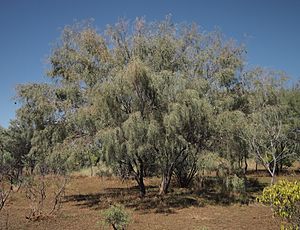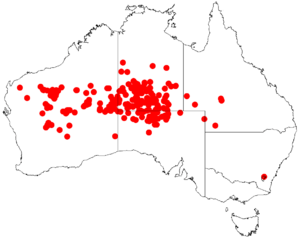Weeping mulga facts for kids
Quick facts for kids Weeping mulga |
|
|---|---|
 |
|
| Scientific classification | |
| Genus: |
Acacia
|
| Species: |
paraneura
|
 |
|
| Occurrence data from AVH | |
Acacia paraneura, also known as the weeping mulga, is a special kind of tree or shrub. It belongs to a big family of plants called Acacia. You can find it growing naturally in the dry, desert-like parts of Australia. The Kurrama people, who are Indigenous Australians, call this tree warlun.
Contents
What Does Weeping Mulga Look Like?
The weeping mulga can grow in different ways depending on where it is in Australia.
- In Western Australia, it usually grows to be about 3 to 10 meters (10 to 33 feet) tall.
- It can have one main trunk or many trunks growing from its base.
- Its top part, called the crown, can look open or a bit wispy.
- The stems and branches have grey bark. This bark often has long cracks in it, especially on the main trunk.
Leaves, Flowers, and Seeds
The leaves of the weeping mulga are not typical flat leaves. Instead, they have special leaf-like parts called phyllodes.
- These phyllodes are a dull green or grey-green color.
- They are usually straight or slightly curved.
- Each phyllode can be 6 to 23 centimeters (2.4 to 9.1 inches) long.
- They are very thin, only about 0.8 to 1.2 millimeters (0.03 to 0.05 inches) wide.
When the weeping mulga flowers, it produces simple, golden, spike-like flowers.
- These flower spikes are about 10 to 30 millimeters (0.4 to 1.2 inches) long.
- In Western Australia, it usually flowers from June to September.
- It can also flower at other times, especially after a lot of rain.
After flowering, the plant forms flat seed pods.
- These pods are oblong or narrowly oblong in shape.
- They can be 2 to 9 centimeters (0.8 to 3.5 inches) long.
- They are about 7 to 17 millimeters (0.3 to 0.7 inches) wide.
- Inside the pods are shiny brown seeds.
- These seeds are 4 to 7 millimeters (0.16 to 0.28 inches) long and about half as wide.
Naming the Weeping Mulga
Plants often have scientific names that help scientists around the world know exactly which plant they are talking about.
- The weeping mulga's scientific name, Acacia paraneura, was first officially described in 1992.
- A botanist named Barbara Rae Randell wrote about it in a science journal.
- Later, another botanist, Leslie Pedley, tried to put it in a different group in 2003.
- But by 2006, it was moved back to the Acacia group.
What Does "Paraneura" Mean?
The second part of its scientific name, paraneura, comes from ancient Greek words.
- Para means "near".
- Aneura means "without nerves".
- This name was chosen because the plant's phyllodes (leaf-like parts) look similar to another Acacia species called Acacia aneura, which means "without nerves" because its phyllodes don't have obvious veins.
Where Does Weeping Mulga Grow?
The weeping mulga grows in several parts of Australia.
- You can find it in northern South Australia.
- It also grows in the southern part of the Northern Territory.
- And it's found in the far western part of Queensland.
- In Western Australia, it lives in the Pilbara, Mid West, and Goldfields regions.
Its Favorite Places to Grow
This plant can grow in different kinds of environments across Australia.
- In Western Australia, it prefers sandy or clay soils.
- It is often found on stony plains.
- You might also see it in clay-pans, which are flat areas where water collects, especially near drainage lines.
- It grows in low woodland areas.
- It often shares its home with other types of Acacia trees, like Acacia aneura, Acacia catenulata, and Acacia distans.
- You might also find it growing with plants from the Eremophila family.

